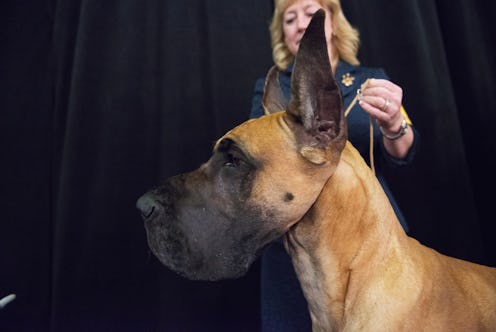Life
5 Myths About Having A Big Dog That Are Totally Untrue

There are two kinds of people in the world: small-dog people and big-dog people. And while some people might be happy with a dog that weighs under 5 pounds and fits in a handbag, I want my canines big enough to pull a broken-down car and then knock me over for a cuddle. But the largest dog breeds, in addition to being ginormous baskets of floof, come with a host of myths and misconceptions about them. Your Great Danes, your Newfoundlands, or Afghans are not very well understood.
Larger animals do often need more space and won't necessarily flourish in apartments or cramped living conditions. And they're often more expensive than some smaller breeds to insure, though that changes depending on their parentage and hereditary health conditions. But they're not innately more "difficult" or aloof because they happen to be bigger. Large breed dogs, like all dogs, require training, particularly because their strength means they can disobey you if they want to. But if you want a big beautiful friend in your house, and don't mind if it occasionally competes with you for the couch and wins, then it's time to clear the air and get a few misguided ideas about big dogs out of the way.
1"They Need A Lot Of Exercise"
It's not the size of the dog that determines how much exercise they should have; it's mostly about their breed and their weight. Bigger dogs don't necessarily require a lot of exercise; the ones that require the most walks and play are working dogs who've been bred to spend a lot of time moving, including collies, Australian shepherds and other herding dogs. Very big dogs who aren't herders, however, often require just one walk a day and will spend the rest of the time lying around. Adult Great Danes, for instance, only need 30 to 60 minutes of exercise a day.
2"They're Dangerous Around Children"
This is a daft misconception that can't be further from the truth. Big dog breeds that are family-friendly are pretty common; Labrador retrievers, Irish setters, large poodles and bull terriers are all regarded as excellent protectors and very good with kids. Newfoundlands and other massive dogs are gentle giants who provide another advantage: kids can climb all over them. All dogs who are going to be around kids, though, need training so that they can be controlled and know appropriate behavior.
3"They Dominate Other Dogs And Humans"
It's not actually true that bigger dogs are born to feel more dominant than others. Any dog can become excessively dominant, though it's more likely if they're male and un-neutered. Cesar Milan notes that humans need to take the lead to control dominant dogs, but small dogs are just as inclined to dominance as smaller ones. Don't let a big breed get away with over-protective or combative behavior because it's big; it'll feel more secure with good training that shows that it's not actually in charge.
4"They're Harder To Train"
Some of the most intelligent and responsive dogs in training are bigger ones, including the larger breeds of poodle and German shepherds. The main training issue with larger dogs is that their strength means it's necessary to teach them obedience, as otherwise they can pull you around the park with you. It's also a good idea to train them out of jumping on people in greeting. While it may look cute, a full-size Leonberger who wants a cuddle will probably knock your grandmother over.
5"They're More Prone To Health Conditions"
Larger dogs do have their own health problems, largely due to their higher weight; joint problems like arthritis tend to be an issue. Smaller breeds are also estimated to live a bit longer. However, one of the biggest indicators of health isn't size; it's whether or not they've been purebred. Pure-breed dogs tend to have a higher incidence of health issues than mixed breeds because of hereditary traits that have made their lives harder, from German Shepherds' spinal issues to the breathing problems of pugs and other snub-nosed dogs.
All animals come with their own risks, character, temperament and health history, so don't make assumptions based on a dog's size the second you see it. That giant mutt may be the best mate you ever have.